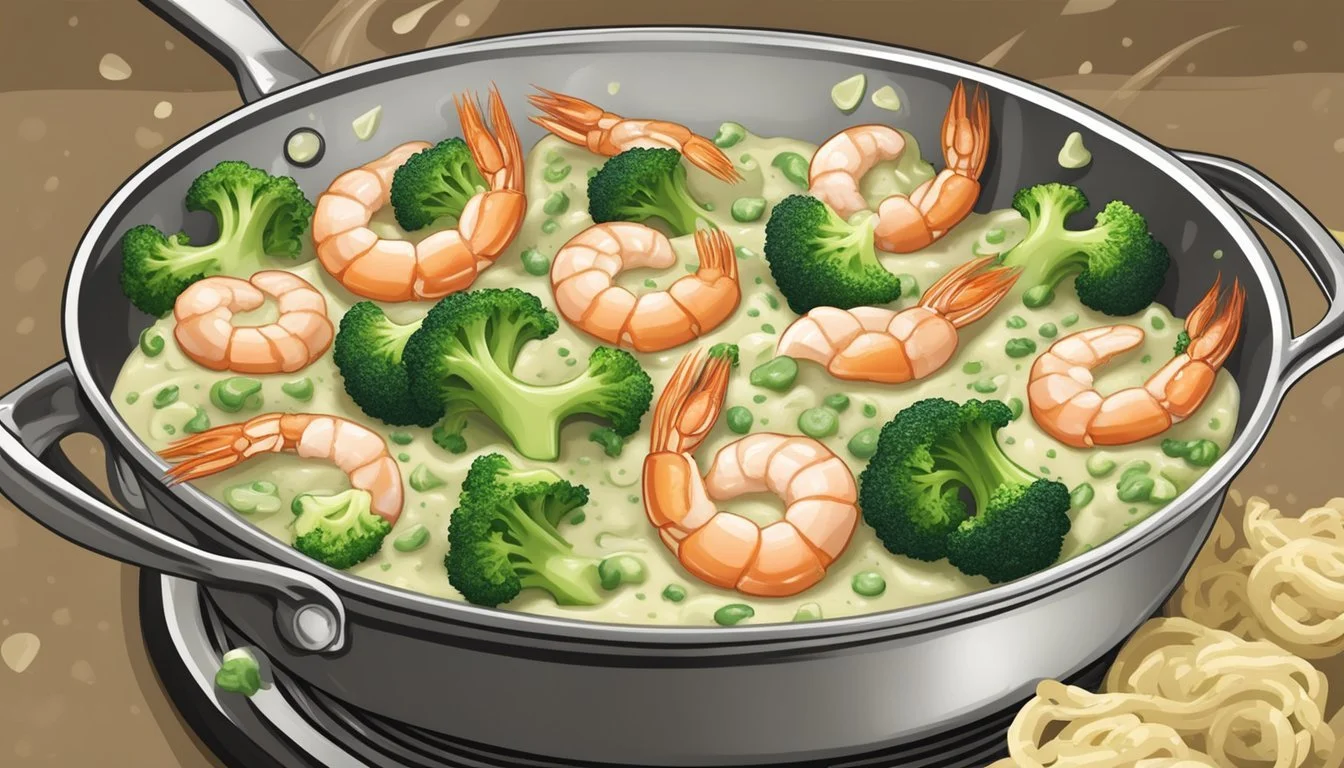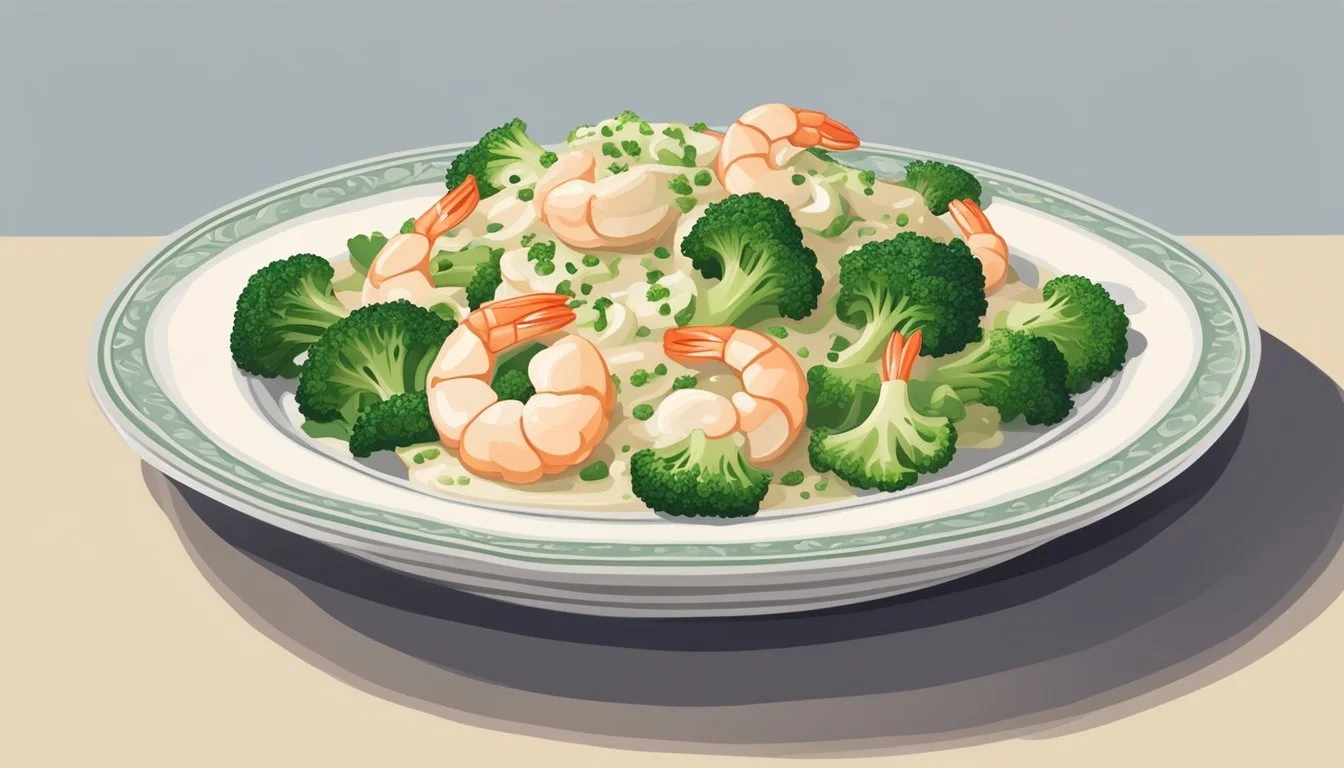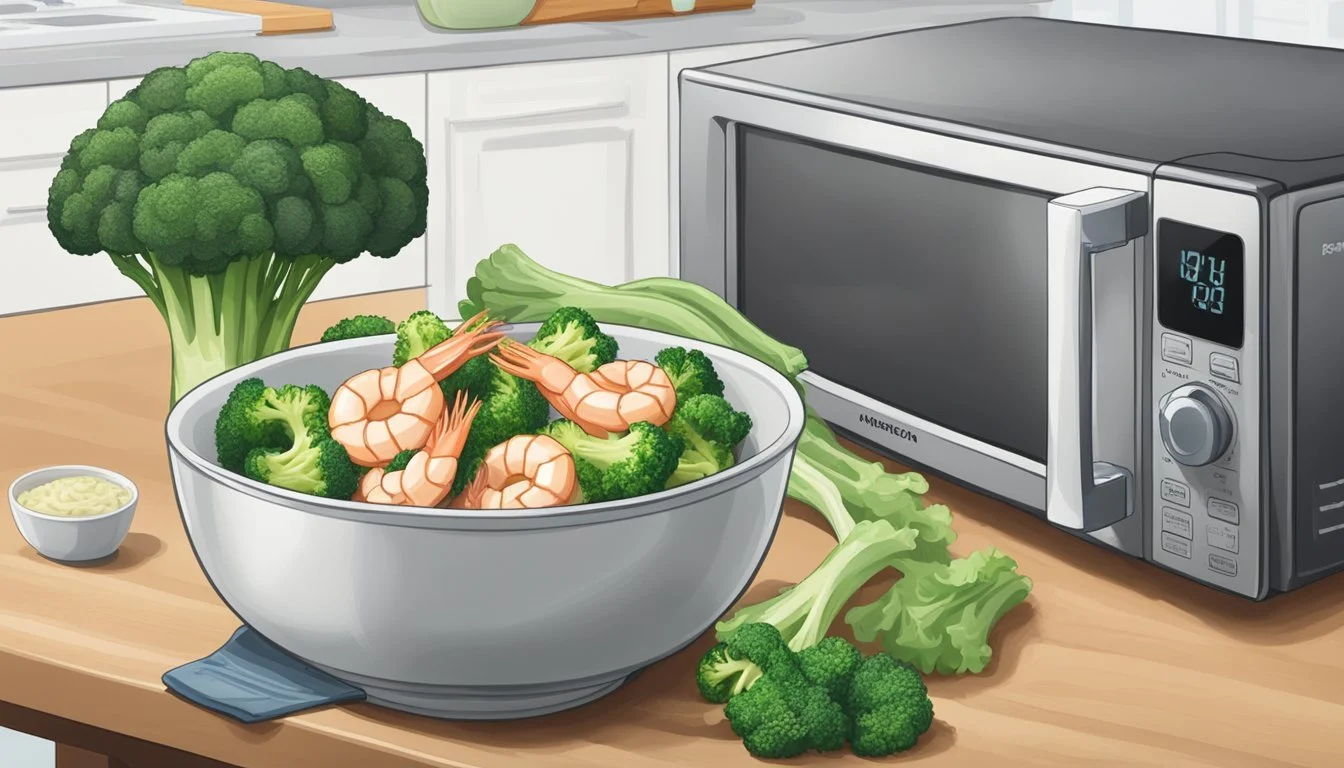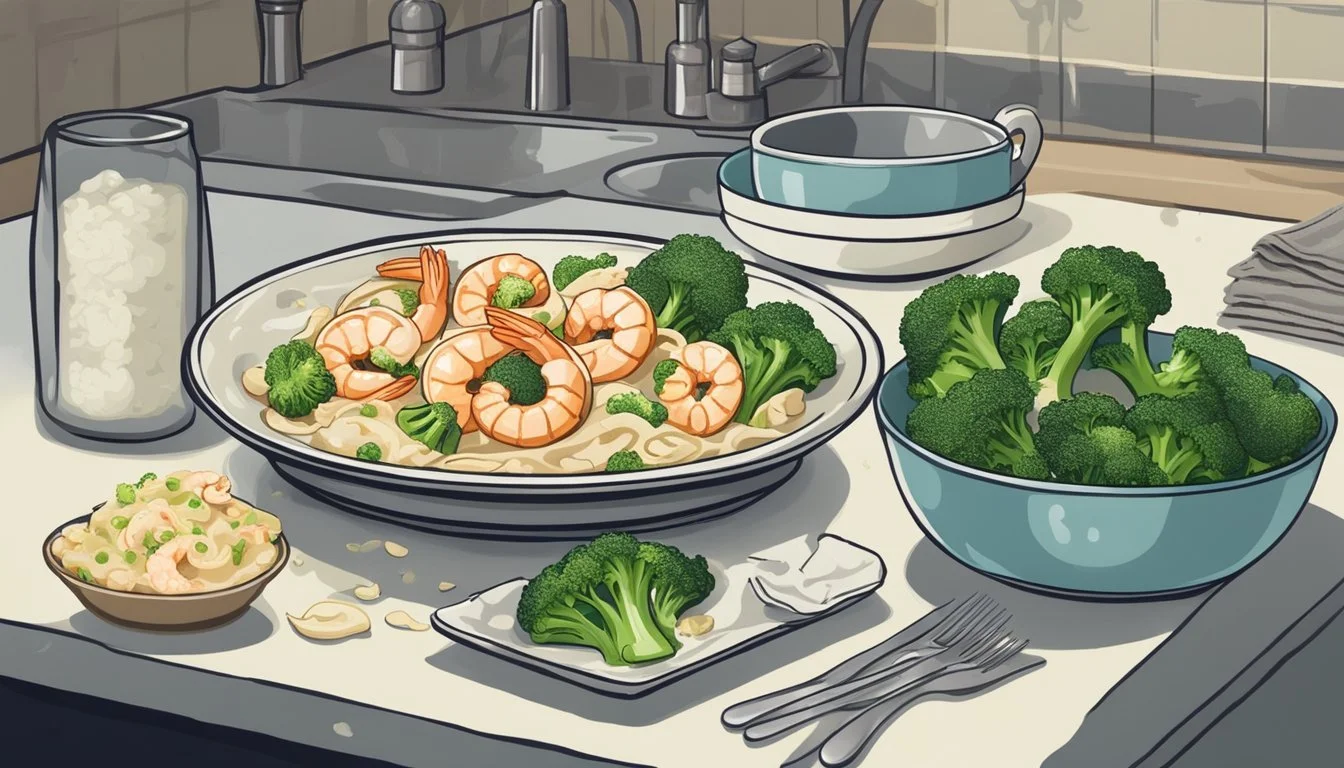How Long Does Alfredo Shrimp and Broccoli Last?
Expert Storage Tips
When it comes to enjoying a delicious dish like Alfredo shrimp and broccoli, knowing how long it lasts can save you from potential food safety issues. Proper storage is key to maintaining the quality and taste of this creamy dish. Alfredo shrimp and broccoli can last up to 3-4 days in the refrigerator when stored in an airtight container.
For those who might prepare this meal in advance or have leftovers, it’s essential to store it correctly to maximize its shelf life. Refrigeration slows down bacterial growth, but for the best flavor and safety, consuming the dish within the recommended time frame ensures a delightful experience. Freezing Alfredo shrimp and broccoli is an option for longer preservation, but it's important to note that the texture of the sauce and shrimp may change when thawed and reheated.
Understanding these storage guidelines allows you to safely enjoy your Alfredo shrimp and broccoli while minimizing food waste. Knowing how to properly store this dish not only keeps it safe to eat but also ensures it remains just as delicious as when it was first prepared.
Understanding Alfredo Shrimp and Broccoli
Alfredo Shrimp and Broccoli is a delicious dish combining the flavors of shrimp, broccoli, and a rich Alfredo sauce. Shrimp is a healthy seafood choice, offering lean protein and low-fat content. Broccoli provides essential nutrients like fiber and vitamins.
In the Alfredo sauce, garlic and Parmesan cheese add a savory depth. The sauce typically includes cream and cream cheese, creating a smooth, creamy texture. Olive oil might be used for sautéing the shrimp, imparting a subtle richness.
Nutrition Facts:
Ingredient Nutrient Benefits Shrimp Protein Supports muscle growth Broccoli Fiber, Vitamins Aids digestion, boosts immunity Garlic Antioxidants Supports heart health Parmesan Calcium, Protein Strengthens bones Cream Fat, Calories Provides energy
Cooking Process:
Cook shrimp in olive oil until pink, adding salt and pepper.
Steam or sauté broccoli until tender.
Prepare Alfredo sauce with garlic, cream, and Parmesan.
Each ingredient brings unique flavors and nutrients to the dish. The combination of seafood with vegetables ensures a balanced meal. This dish can also be found in various restaurants, often served with pasta.
Despite its richness, the use of shrimp and broccoli keeps it relatively healthy. The fat from the cream is counterbalanced by the lean protein of the shrimp and the fiber in the broccoli. It's a satisfying and nutritionally varied option.
Essential Ingredients
The key elements of Alfredo Shrimp and Broccoli are a combination of fresh proteins and vegetables, coupled with rich and creamy sauce components. Each ingredient plays a crucial role in achieving the desired flavor and texture.
Proteins and Vegetables
Shrimp and Broccoli: Shrimp serves as the main protein, providing a delicate seafood flavor and lean protein content, essential for a satisfying meal. Shrimp should be fresh or properly thawed if frozen, and cooked until pink and opaque.
Broccoli: This vegetable adds a burst of green color and is rich in vitamins and minerals. Broccoli should be cut into small florets and cooked until fork-tender to ensure it melds well with the creamy sauce.
Garlic: Adding minced garlic enhances the aromatic flavor, complementing both the shrimp and broccoli. Sautéing the garlic in olive oil or butter releases its full potential, integrating seamlessly into the dish.
Creamy Sauce Components
Butter: A staple in Alfredo sauce, butter gives the sauce its rich base. It should be melted and combined with garlic and other ingredients to form a smooth mixture.
Heavy Cream and Milk: These dairy components create the creamy texture Alfredo sauce is known for. They blend with the butter to form a luscious, thick sauce. For a lighter version, a mixture of milk and a smaller amount of heavy cream can be used.
Parmesan Cheese: Freshly grated Parmesan cheese is key for incorporating a nutty, salty profile into the sauce. It melts into the cream and butter, creating the signature Alfredo consistency.
Cream Cheese: A small amount of cream cheese adds tanginess and extra creaminess to the sauce, enhancing its overall flavor profile.
Seasonings: Salt and pepper are essential for seasoning the sauce to taste. Adjust these carefully to strike the perfect balance of flavors. Additional spices like onion powder can also be used to add depth without overpowering the dish.
Each ingredient is vital for creating a delicious Alfredo Shrimp and Broccoli dish, contributing to both its nutrient profile and its irresistible taste.
Preparation Techniques
When preparing Alfredo Shrimp and Broccoli, it is essential to master cooking the pasta, making the Alfredo sauce, and properly preparing the shrimp and broccoli. Each step ensures the dish's flavors and textures come together perfectly.
Cooking Pasta
Cooking pasta for this dish typically involves fettuccine noodles, which should be cooked to an al dente texture. Start with a large pot of salted boiling water, adding the uncooked fettuccine and stirring occasionally to prevent sticking. The total time to boil the pasta usually ranges from 10 to 12 minutes.
Once the pasta reaches the desired firmness, drain the fettuccine but reserve about half a cup of the pasta water for later use. This pasta water contains starch and can help adjust the consistency of the Alfredo sauce.
Making Alfredo Sauce
Creating a rich Alfredo sauce involves several key steps. Begin by melting butter over medium heat in a large skillet. Add minced garlic and sauté until fragrant. Next, pour in heavy cream and cream cheese, whisking continuously until the mixture is smooth and starts to simmer.
Gradually add grated parmesan cheese while continuing to stir. The sauce should thicken and become creamy. Season with salt and pepper to taste. If the sauce is too thick, add a bit of the reserved pasta water to reach the desired consistency.
Preparing Shrimp and Broccoli
The final components, shrimp and broccoli, require careful preparation. Use deveined shrimp and season with olive oil, salt, and pepper. In a large skillet over medium heat, cook the shrimp until they turn pink and opaque, which usually takes about 4-6 minutes.
In the same skillet, add broccoli florets and a small amount of water. Cover and cook until the tender broccoli is fork-tender, around 5-7 minutes. Drain any excess water. Once cooked, combine the shrimp and broccoli with the alfredo sauce and pasta for a cohesive and flavorful dish.
Cooking Time and Techniques
Cooking Shrimp and Broccoli Alfredo typically requires 20-40 minutes from start to finish. This dish involves a combination of boiling, sautéing, and simmering.
Prep Time
Prep time usually entails chopping broccoli, cleaning and deveining shrimp, and gathering ingredients like garlic, butter, and seasonings. It takes about 10-15 minutes.
Boiling the Pasta
Boil a large pot of salted water. Cook pasta according to package directions, often around 8-10 minutes for al dente. Reserve some pasta water before draining.
Cooking Shrimp and Broccoli
In a large skillet, heat oil or butter over medium heat. Add shrimp and sauté for approximately 4-6 minutes until pink and opaque. Remove the shrimp and set aside.
Add broccoli to the same skillet with some water, cover, and simmer for about 4-6 minutes until fork-tender. Drain any remaining liquid.
Combining Ingredients
Return shrimp to the skillet with the broccoli. Stir in cooked pasta and add a creamy Alfredo sauce. Let it simmer over medium-low heat until the sauce thickens and everything is well-coated, approximately 5-7 minutes.
Key Points
Total Time: 20-40 minutes
Tools: Large pot for boiling, large skillet for sautéing
Steps: Boil pasta, sauté shrimp, simmer broccoli, combine and simmer with sauce
The primary techniques involve boiling, sautéing, and simmering to ensure a delicious and well-cooked Alfredo meal. Use these steps as a clear guide to create this classic dish efficiently.
Quality and Freshness
Ensuring the quality and freshness of alfredo shrimp and broccoli relies on selecting premium ingredients and following proper storage practices. Here’s how to maintain the dish's optimal taste and safety.
Identifying Fresh Ingredients
Shrimp: Fresh shrimp should have a sea-like smell, firm texture, and translucent appearance. Avoid shrimp that are slimy, have black spots, or smell of ammonia. For frozen shrimp, check for ice crystals or freezer burn.
Broccoli: Fresh broccoli boasts a bright green color with firm stalks and compact florets. Yellowing florets or a rubbery texture indicate aging.
Cream and Cheese: Use heavy cream and fresh Parmesan cheese. Fresh cream should be rich and smooth without separation. Parmesan cheese should have a pungent but pleasant aroma and firm texture. Fresh parsley should be vibrant green with no wilting.
Storage Recommendations
Leftovers: Refrigerate within two hours of cooking. Store in an airtight container to prevent moisture loss and bacterial growth.
Optimal Refrigeration Time: Alfredo shrimp and broccoli generally last 3-4 days in the fridge. This is assuming the refrigerator maintains a consistent temperature of 40°F (4°C) or below.
Frozen Shrimp: If using frozen shrimp, defrost in the refrigerator overnight, not at room temperature, to maintain quality and safety.
Freezing Leftovers: For longer storage, portion leftovers into airtight containers or zip-lock bags, removing as much air as possible before freezing. Alfredo shrimp and broccoli can be frozen for up to 2 months. Thaw overnight in the refrigerator before reheating.
Health and Nutrition Facts
Broccoli Shrimp Alfredo combines hearty shrimp, nutritious broccoli, and creamy sauce, making it both delicious and energy-dense. Key aspects include caloric content and the macronutrient profile, which highlights the balance of proteins, fats, and carbohydrates.
Caloric Content
The calorie count of Broccoli Shrimp Alfredo varies, generally offering a significant energy boost. A typical serving size includes about 400-600 calories, largely dependent on portion size and specific preparation methods.
Shrimp is relatively low in calories, around 84 calories per 3-ounce serving, while broccoli adds roughly 55 calories per cup. The Alfredo sauce, rich in cream and cheese, heavily influences the dish's calorie density with around 100-200 calories per serving, primarily from fats and dairy.
Macronutrients Profile
Broccoli Shrimp Alfredo offers a well-rounded macronutrient composition. Protein is a key feature, with shrimp providing about 20 grams of protein per 3 ounces, supporting muscle maintenance and growth. Broccoli contributes around 3 grams of protein per cup.
Fats are significant in Alfredo sauce, with noticeable levels of saturated fat from cream and cheese—around 10-15 grams per serving. This includes approximately 5-7 grams of saturated fat. Moderation is key to balancing these fats within a healthy diet.
Carbohydrates primarily come from pasta, with around 20-30 grams per serving—a mix of sugars and complex carbs. Broccoli adds a small amount of fiber, about 2-3 grams per cup, aiding digestion and satiety. These elements make the dish satisfying while providing a balanced nutrient distribution.
Serving and Presentation
For an excellent dining experience, it's essential to know the right accompaniments and garnishing tips to elevate Alfredo Shrimp and Broccoli. Proper presentation plays a key role in making the dish visually appealing, while thoughtful accompaniments can complement its rich flavors.
Accompaniments
Light side dishes such as steamed asparagus or carrots pair well with Alfredo Shrimp and Broccoli. Their mild flavors and crisp texture contrast nicely with the creamy sauce.
For a touch of freshness, consider a fruit salad. The sweetness of the fruit balances the savory elements of the Alfredo.
A crisp, green salad with a light vinaigrette can add a refreshing counterpoint to the richness of the Alfredo.
When serving this dish, think about adding a warm, crusty bread like a French baguette or garlic bread, perfect for soaking up the Alfredo sauce.
Garnishing Tips
Enhance the visual appeal and flavor profile with thoughtful garnishes. A sprinkle of grated Parmesan cheese not only adds an extra layer of taste but also provides a sophisticated look.
Fresh parsley, finely chopped, offers a burst of color that stands out against the creamy sauce.
Consider adding a pinch of black pepper or red pepper flakes for a hint of spice. For added color and flavor, you can use paprika.
Hand-torn basil leaves can introduce a delicate, aromatic note. The vibrant green leaves also contribute a lovely contrast to the dish.
Following these tips, Alfredo Shrimp and Broccoli can be transformed into a restaurant-quality dish right at home.
Variations and Substitutions
Different ingredients and substitutions can provide a twist to classic Shrimp and Broccoli Alfredo, catering to various dietary preferences and enhancing the dish's flavor.
Alternative Ingredients
Using cream and parmesan cheese as the base for Alfredo sauce is traditional. For a healthier option, whole milk or even cauliflower Alfredo can substitute heavy cream while maintaining creaminess. Adding zucchini or other vegetables can provide extra nutrients and a different texture.
Seasonings such as onion powder can boost flavor. If you're avoiding dairy, non-dairy milk and nutritional yeast can replace milk and cheese. For a thicker sauce, all-purpose flour can be used as a thickening agent instead of more traditional ingredients.
Vegetarian Options
For those seeking a vegetarian alternative, replacing shrimp with more vegetables or plant-based proteins like tofu or tempeh is effective. Cauliflower Alfredo sauce offers a creamy and delicious option for the traditional cream-based sauce.
Mushrooms, zucchini, and other vegetables can enhance texture and flavor. Incorporating a mix of these alternatives can cater to different dietary needs while preserving the dish's richness and satisfaction. Reducing the cooking time for delicate vegetables ensures they remain fresh and crispy.
Shelf Life and Spoilage
Alfredo shrimp and broccoli can be stored in the fridge for a limited time to maintain their taste and safety.
Refrigeration Guidelines:
Freshness: When properly stored in an airtight container, the dish can last 3 to 4 days.
Temperature: Ensure your refrigerator is set at or below 40°F (4°C).
It’s important to refrigerate leftovers within 2 hours of cooking to prevent bacterial growth.
Visual Indicators of Spoilage:
Color: Any change in color, such as a dull or gray appearance in the shrimp, indicates spoilage.
Texture: If the broccoli becomes mushy or the sauce separates extensively, it’s no longer safe to eat.
Smell and Taste:
Odor: A sour or off smell is a strong indicator that the dish has spoiled.
Flavor: Tasting a small amount may also reveal spoilage—any off flavors suggest it's time to discard it.
Freezing Tips:
If you need to store it longer, freezing is an option. Seal in an airtight container and freeze immediately. Properly frozen, it can last up to 2 to 3 months.
Avoiding Spoilage:
Portion Control: Only reheat the amount you plan to consume.
Reheating: Heat leftovers to an internal temperature of 165°F (74°C) to ensure safety.
Following these guidelines helps keep your alfredo shrimp and broccoli dish safe and enjoyable for several days.
Video Tutorials and Recipes
Those interested in making Shrimp and Broccoli Alfredo have access to numerous online resources. Video tutorials can provide step-by-step guidance, while curated recipe collections offer a variety of takes on this popular dish.
Online Cooking Demonstrations
Online video platforms such as YouTube feature numerous cooking demonstrations for Shrimp and Broccoli Alfredo. These videos break down the process into manageable steps, making it easier for viewers to follow along.
For instance, one video titled "Broccoli Shrimp Alfredo Pasta Recipe" claims that the dish can be made in just 20 minutes using simple ingredients. This is useful for those looking for quick meal solutions.
Another video, "Creamy Shrimp Broccoli Alfredo - 30 Minute Meal," shows how to enhance your meal with a creamy Alfredo sauce. These videos often include tips on ingredient substitutions and cooking techniques, making them invaluable for beginners and experienced cooks alike.
Recipe Collections
Several websites offer detailed shrimp recipes, including Shrimp and Broccoli Alfredo. For example, the site Creme De La Crumb provides step-by-step instructions that include sautéing the shrimp and steaming the broccoli.
These recipes often detail the required ingredients such as shrimp, broccoli, fettuccine pasta, and the components for the Alfredo sauce. Some recipes, like "Shrimp and Broccoli Alfredo (40 Minutes) Recipe," specify the estimated cooking times for each step.
Additionally, many recipe collections provide variations, such as using different types of pasta or adding other vegetables. By exploring various recipes, cooks can find the version that best suits their tastes and time constraints.
Tips for Quick Meals
Quick meals can be a lifesaver on busy days. Here are some tips to make preparation fast and efficient:
Preparation: Plan ahead. Having ingredients prepped and stored can drastically reduce cooking time. For instance, chopping broccoli in advance or having shrimp pre-cleaned can save precious minutes.
Stock Basics: Keep your pantry stocked with essentials like pasta, garlic, and canned veggies. This ensures you always have what you need to throw together a meal quickly.
Simplify Steps: Use pre-made components. Pre-made Alfredo sauce or pre-cooked pasta can shave off considerable time.
Proper Equipment: Invest in tools like a skillet or a blender. These can streamline cooking tasks and improve overall efficiency.
Example Quick Meal: Shrimp and Broccoli Alfredo
Time (minutes) Steps 5-7 Cook shrimp in skillet 8-10 Boil pasta 4-6 Steam or microwave broccoli 3-4 Combine pasta, shrimp, broccoli with sauce
Using these tips, meals like Shrimp and Broccoli Alfredo can be ready in around 30 minutes. Always strive to integrate practical time-saving measures to make meal preparation fast and easy.
Cleaning Up
Tackling the cleanup process efficiently ensures your kitchen remains orderly and your utensils stay in good condition after preparing shrimp and broccoli alfredo.
Pasta Pot and Skillet Care
Proper care of your pasta pot and large skillet is crucial to maintain their longevity. Begin by allowing the pot and skillet to cool down before cleaning. Avoid soaking hot cookware immediately in cold water to prevent warping.
Use a soft sponge and mild dish soap to clean the residue.
For stubborn stains, create a paste of baking soda and water, applying it gently.
Rinse off with warm water and dry thoroughly with a clean towel to avoid water spots.
Non-stick skillets require special attention. Avoid using metal utensils to prevent scratching the surface. Instead, opt for wooden or silicone tools.
Storing Leftovers
Proper storage of shrimp and broccoli alfredo ensures freshness and safety. After cooling, transfer the alfredo to an airtight container.
Label the container with the date.
Refrigerate promptly within two hours of cooking to hinder bacterial growth.
Shrimp alfredo leftovers can last in the fridge for 3-4 days. When reheating, make sure to reach an internal temperature of 165°F (74°C) to ensure food safety. To maintain its creamy texture, add a splash of milk or cream when reheating.
Additionally, consider separating the pasta and sauce in different containers to prevent sogginess. This way, both components retain their optimal texture.









